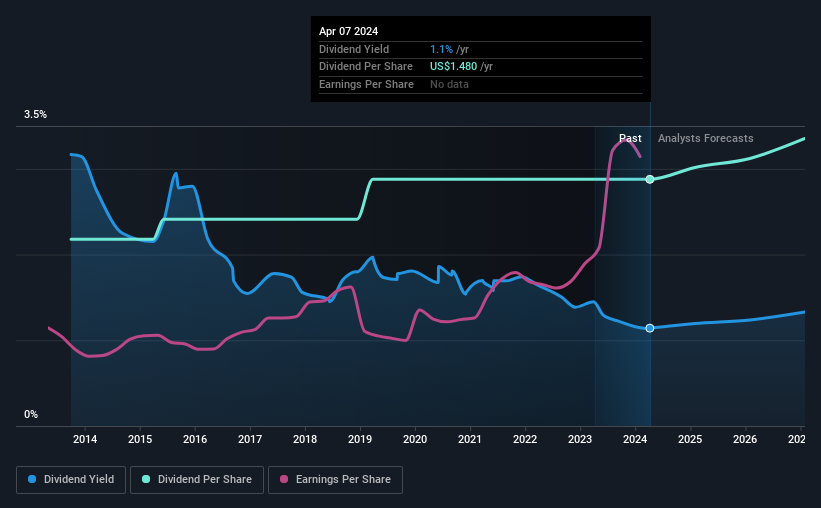Science Applications International Corporation (NASDAQ:SAIC) Looks Like A Good Stock, And It's Going Ex-Dividend Soon
Regular readers will know that we love our dividends at Simply Wall St, which is why it's exciting to see Science Applications International Corporation (NASDAQ:SAIC) is about to trade ex-dividend in the next 3 days. The ex-dividend date is one business day before a company's record date, which is the date on which the company determines which shareholders are entitled to receive a dividend. The ex-dividend date is important because any transaction on a stock needs to have been settled before the record date in order to be eligible for a dividend. Therefore, if you purchase Science Applications International's shares on or after the 11th of April, you won't be eligible to receive the dividend, when it is paid on the 26th of April.
The company's next dividend payment will be US$0.37 per share. Last year, in total, the company distributed US$1.48 to shareholders. Last year's total dividend payments show that Science Applications International has a trailing yield of 1.1% on the current share price of US$129.66. Dividends are an important source of income to many shareholders, but the health of the business is crucial to maintaining those dividends. We need to see whether the dividend is covered by earnings and if it's growing.
See our latest analysis for Science Applications International
If a company pays out more in dividends than it earned, then the dividend might become unsustainable - hardly an ideal situation. Science Applications International paid out just 16% of its profit last year, which we think is conservatively low and leaves plenty of margin for unexpected circumstances. That said, even highly profitable companies sometimes might not generate enough cash to pay the dividend, which is why we should always check if the dividend is covered by cash flow. What's good is that dividends were well covered by free cash flow, with the company paying out 21% of its cash flow last year.
It's positive to see that Science Applications International's dividend is covered by both profits and cash flow, since this is generally a sign that the dividend is sustainable, and a lower payout ratio usually suggests a greater margin of safety before the dividend gets cut.
Click here to see the company's payout ratio, plus analyst estimates of its future dividends.
Have Earnings And Dividends Been Growing?
Businesses with strong growth prospects usually make the best dividend payers, because it's easier to grow dividends when earnings per share are improving. If business enters a downturn and the dividend is cut, the company could see its value fall precipitously. That's why it's comforting to see Science Applications International's earnings have been skyrocketing, up 24% per annum for the past five years. Science Applications International looks like a real growth company, with earnings per share growing at a cracking pace and the company reinvesting most of its profits in the business.
The main way most investors will assess a company's dividend prospects is by checking the historical rate of dividend growth. In the past 10 years, Science Applications International has increased its dividend at approximately 2.8% a year on average. Earnings per share have been growing much quicker than dividends, potentially because Science Applications International is keeping back more of its profits to grow the business.
To Sum It Up
Is Science Applications International worth buying for its dividend? We love that Science Applications International is growing earnings per share while simultaneously paying out a low percentage of both its earnings and cash flow. These characteristics suggest the company is reinvesting in growing its business, while the conservative payout ratio also implies a reduced risk of the dividend being cut in the future. It's a promising combination that should mark this company worthy of closer attention.
While it's tempting to invest in Science Applications International for the dividends alone, you should always be mindful of the risks involved. For instance, we've identified 4 warning signs for Science Applications International (2 are concerning) you should be aware of.
If you're in the market for strong dividend payers, we recommend checking our selection of top dividend stocks.
Have feedback on this article? Concerned about the content? Get in touch with us directly. Alternatively, email editorial-team (at) simplywallst.com.
This article by Simply Wall St is general in nature. We provide commentary based on historical data and analyst forecasts only using an unbiased methodology and our articles are not intended to be financial advice. It does not constitute a recommendation to buy or sell any stock, and does not take account of your objectives, or your financial situation. We aim to bring you long-term focused analysis driven by fundamental data. Note that our analysis may not factor in the latest price-sensitive company announcements or qualitative material. Simply Wall St has no position in any stocks mentioned.

 Yahoo Finance
Yahoo Finance 
